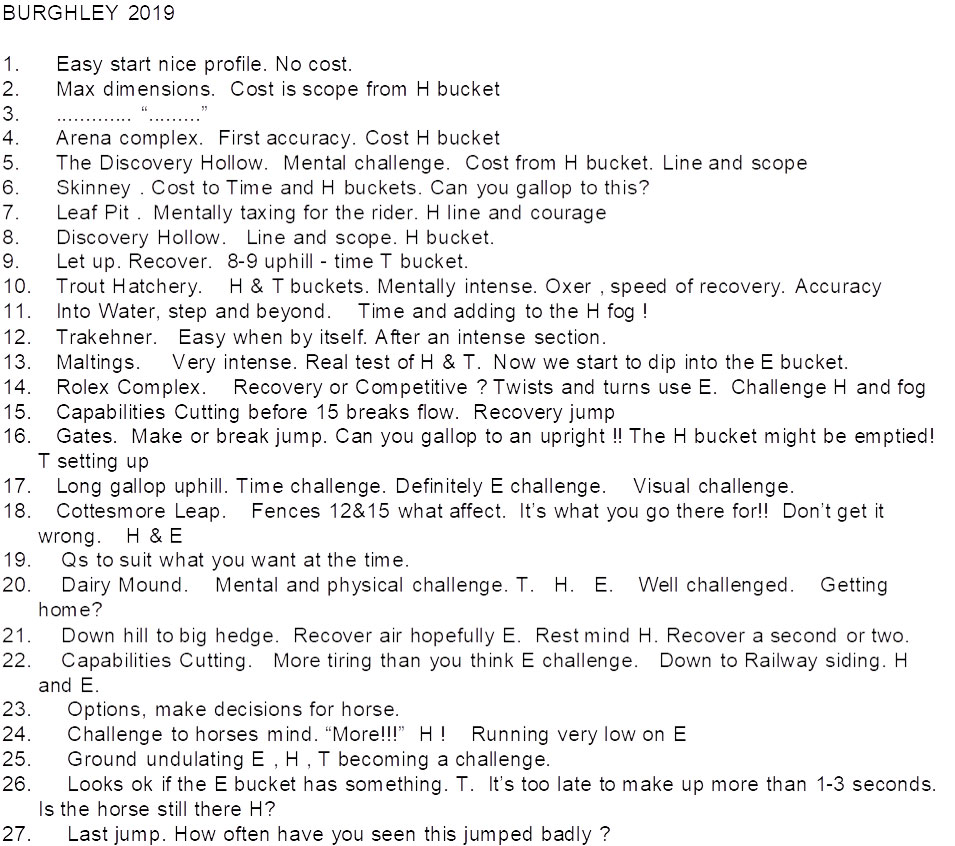Report on the Eric Smiley FBHS “Walk the Course – Manage the Buckets” Zoom Webinar
There were 51 F&I members registered for this presentation which was organised in place of the Badminton course walk which would have been with Eric at Badminton. The evening was organised by our Vice Chairman, Ann Bostock. Thank you, Ann.
There were a few technical communication issues, and the sound quality was not good, but this is what I derived from the evening. The opening presentation slide contained a picture of three buckets – hence the title – Walk the Course and Manage the Buckets
The three buckets were: 1. Energy, 2. Honesty and 3. Time
Eric stressed it was important the week before to think about the rider’s diet and limit alcohol consumption!! and to ensure they ate the right diet.
It was important to manage variables and be aware of the faults, as people will have good and bad days and so will horses, reminding us about the different needs of students and that sometimes it will be necessary to drop down a class to manage the variables. Variables change the ability of the rider to perform. This would be the same process used for 80cm up to 5* level.
Variables may include the ground conditions, the weather, the competition, type of course or area (up and down hills), and the standard the rider should be to compete at that level, plus a host of other variables, too.
Coaching is about empowering the riders to deal with the variables when they compete. As coaches, giving the riders many choices or options whist training the exercises, i.e., different lines and what happens if……, teaching the riders the ability to think as they ride and to think and act quickly as problems may arise throughout the course. When walking the cross-country course, do it in a way that you can understand the variables that are present or what needs to happen if something does not work.
Promote good horsemanship throughout and be thoughtful about what the riders do.
The Burghley Course was given as an example of managing your three buckets, but the buckets need managing at all levels.
- The Time bucket and the time factor – or how you manage the time, what factors will affect this – i.e., the fitness level of the horse and rider, the course itself and ground conditions, and how competitive your rider is and how well prepared the horse is for the level of competition
- The Energy bucket – this is interrelated to help make the time and what the energy costs are relating to the ground conditions and the type of fence you are jumping or how the horse is being ridden throughout the course and how it is being presented to the fences
- The Honesty bucket – this has a direct effect on the amount of energy and is influenced by the above points, and level and intensity of the challenge
Think of the buckets at each fence – each has a challenge, and you need to minimise what you take out from each bucket and to refill your buckets as you go so you finish with a little bit in each bucket.
We then looked at the Burghley Course from 2019 and how the fences were designed. Eric discussed the different fences and which buckets were used.
Overview:
Fence one – a pretty straightforward bench and got the riders going
Fence two – this was a spread and early on questioned the horses which were a bit short on scope and therefore, you have already used a bit from each of your buckets – honesty, time and energy
3 was a table which would question the rider and the horse’s mind – if the approach was a show jumping approach, the honesty level of the horses mind will begin to diminish very early on
Fence 4 was technical with two elements on a curve to the left with 3 strides. Both rider and horse must have quick reactions and know where they are jumping – if too far to the left, the distance would be shorter and too long if you were off to the right. Both would test honesty
Throughout the course, the horse and rider may be aware of other outside influences and distractions such as people, dogs etc. Eric warned “use up your buckets at your peril” as there will be nothing left when you need more. There will be fences on the course used as “let-up” fences where you have a chance to refill your buckets.
When there are different options to take, you need to know which one to take relating to the energy and honesty bucket, especially if there have been problems. Fence 10 involved jumping a fence and dropping down into water and was one of the variable fences that has a mental complexity as well as dipping into your three buckets.
Issues will present themselves at different levels, and you need those thought processes to act quickly as to what options to take and commit to, otherwise there will be problems which will reflect on the honesty experiences of the horses.
Know your horse’s technique and what he jumps well as to which options to go to. Try to refill those buckets throughout the course.
Horses’ legs slow down when jumping into water so there will be an effect on the mental focus, energy, and time. Also, those fences with a lid on the top – horses do not jump as high so when you are coming to maximum height tables with a hood over the top, ensure the canter is good enough to have a good technique and a scopey jump. These sorts of fences are questioning the honesty and time factors.
Eric then advised us to watch the combinations competing at Kentucky, USA and observe how the riders manage their three buckets in different ways.
He went on to emphasise that our job is to teach riders to manage them to save their horses where they can.
The very top riders are particularly good at deceiving – they go half a gear quicker than everybody else and have a high cruising speed.
Knowing what you have got and how to manage it is a skill.
It is also a skill to teach riders how to manage it.
There was lots of information to take in and we would all like to thank Eric for his time and wisdom for sharing this with us.
Thank you, Eric.
Thank you, Ann, for organising.
Report written by Dianne Roberts

